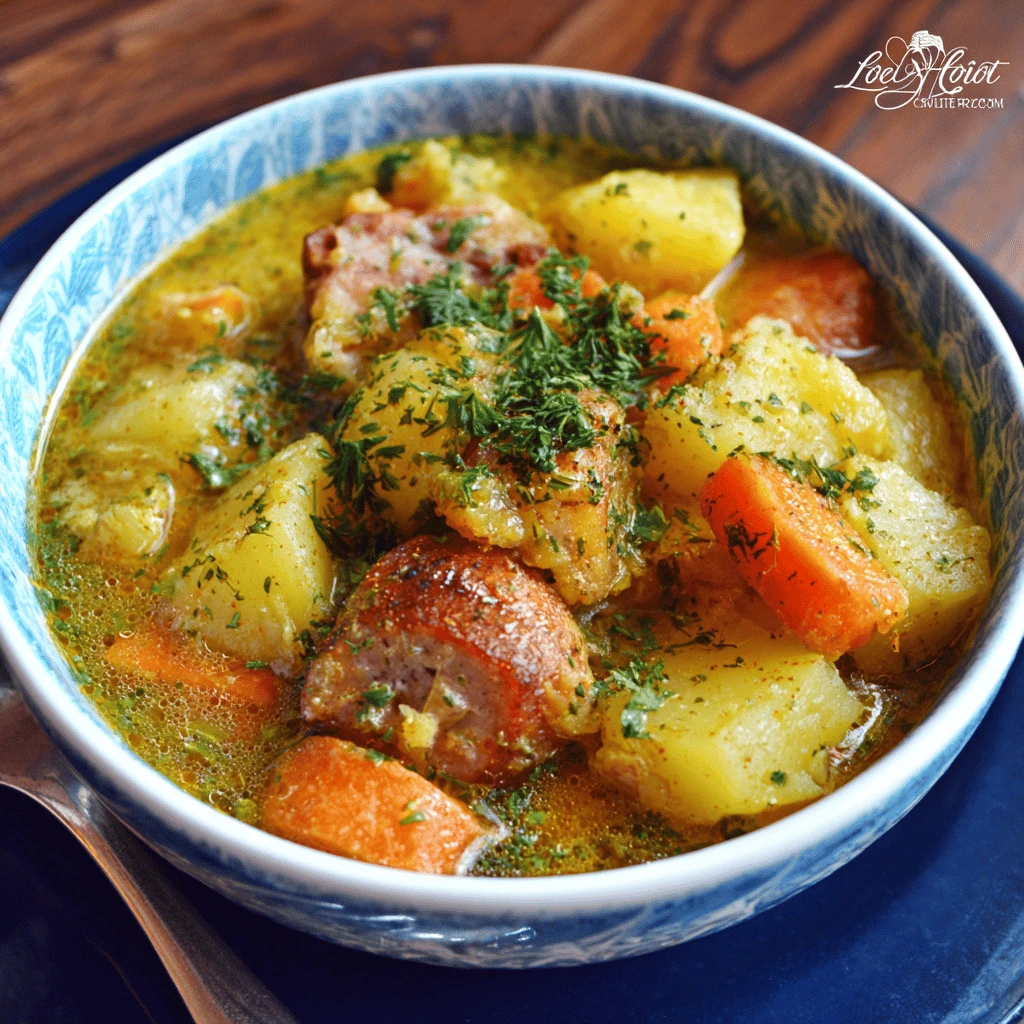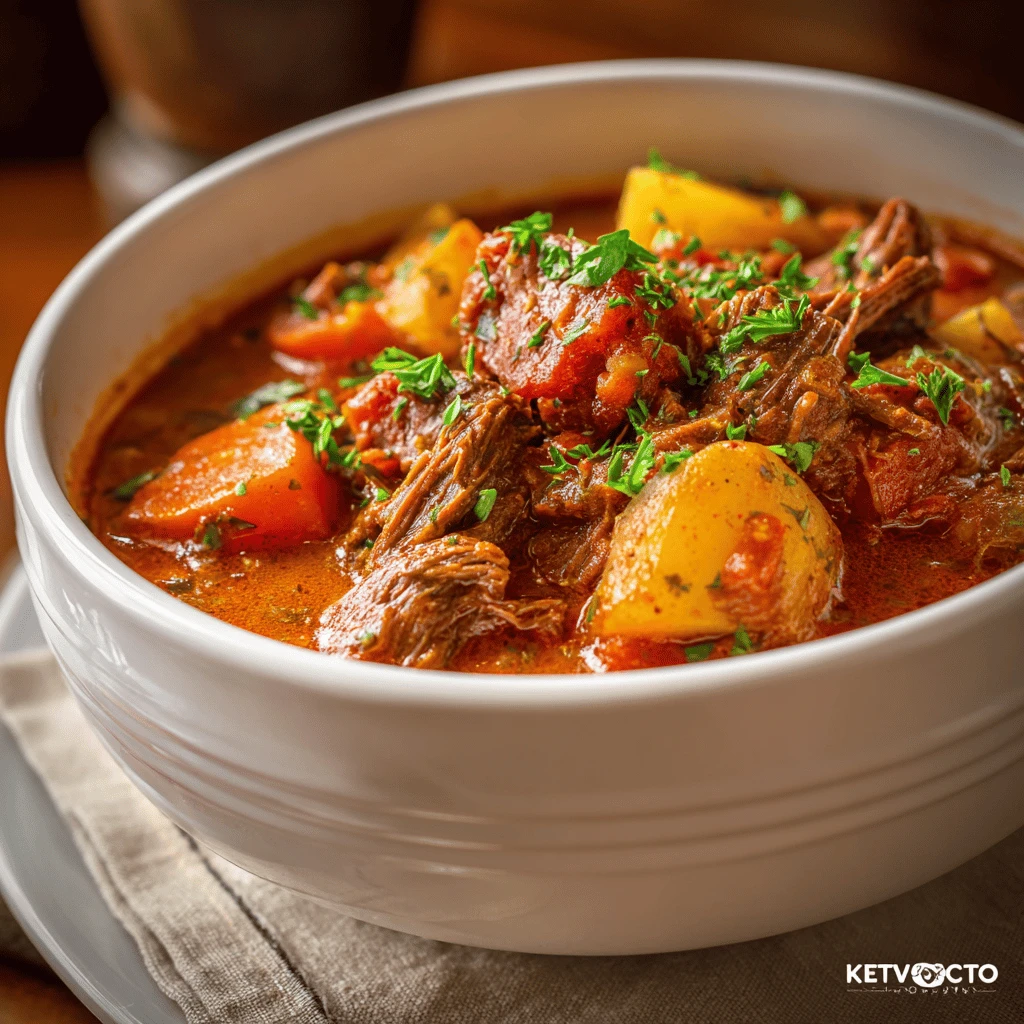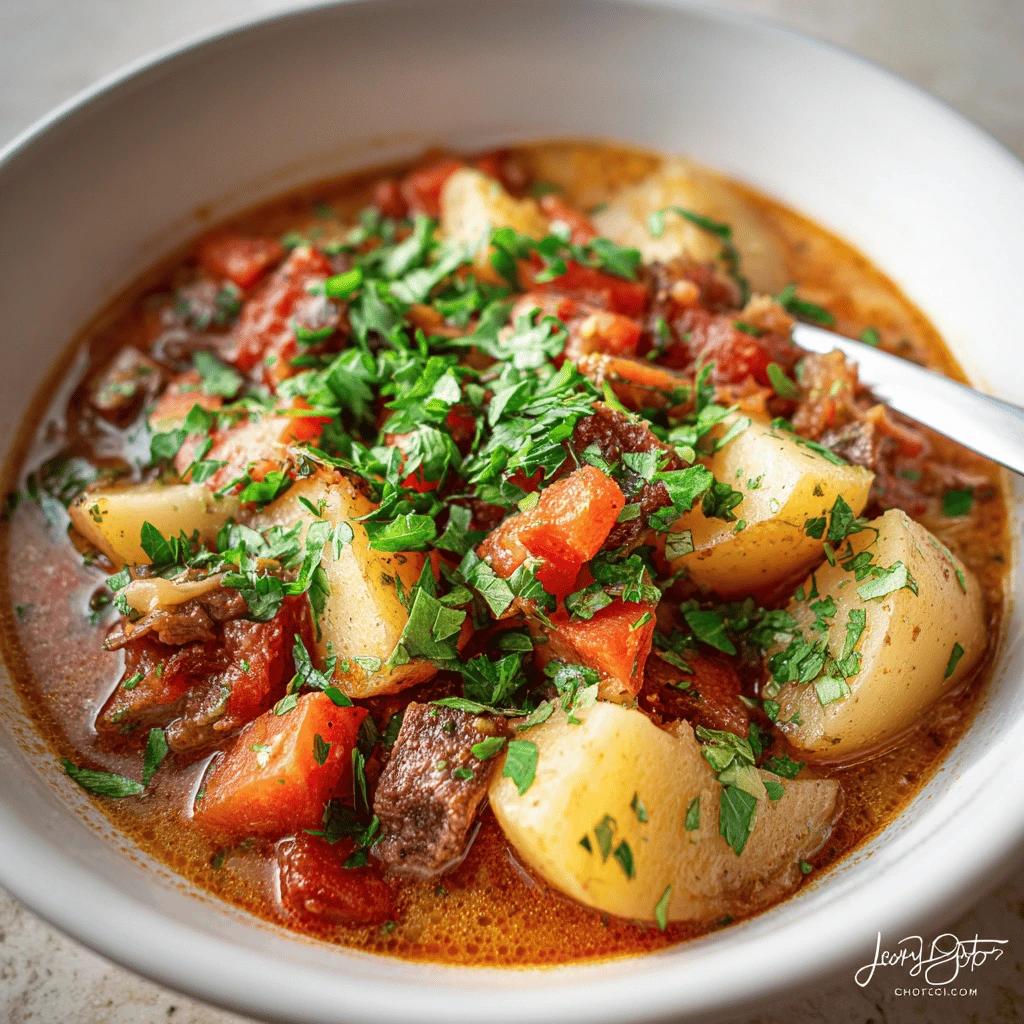Low Carb Crockpot “Potatoes” Stew
Craving a hearty, comforting stew but watching your carbohydrate intake? This low-carb crockpot “potato” stew is the perfect solution. By cleverly substituting traditional potatoes with low-carb alternatives like radishes, turnips, or cauliflower, you can enjoy all the cozy flavors of a classic stew without the guilt. This recipe is easy to customize with your favorite vegetables and protein, making it a versatile and satisfying meal for any day of the week.
Why Choose a Low-Carb “Potato” Stew?
Traditional potato stew is a cold-weather staple, but its high carbohydrate content can be a concern for those following low-carb or ketogenic diets. This low-carb version offers several advantages:
- Reduced Carbohydrate Intake: Replacing potatoes with vegetables like radishes significantly reduces the carb count.
- Increased Fiber: Many low-carb potato substitutes are rich in fiber, promoting healthy digestion and satiety.
- Nutrient-Rich: This stew is packed with vitamins and minerals from various vegetables and protein sources.
- Customizable: Easily adapt the recipe to your dietary preferences and available ingredients.
- Convenient: The crockpot makes cooking effortless – simply add the ingredients and let it simmer!
Choosing Your Low-Carb “Potato” Substitute
The key to a successful low-carb “potato” stew is selecting the right substitute. Here are some excellent options, each with its unique flavor and texture:
- Radishes: When cooked, radishes lose their pungent flavor and develop a mild, potato-like taste. They also have a similar texture to potatoes, making them an ideal substitute. Red radishes are generally preferred as they are more commonly available, but daikon radishes can also be used.
- Turnips: Turnips have a slightly sweeter taste than radishes but also soften well in a stew. Look for smaller turnips, as larger ones can be bitter. Peel them before adding them to the crockpot.
- Cauliflower: Cauliflower florets add a creamy texture to the stew and absorb the flavors of the other ingredients. Be careful not to overcook them, as they can become mushy.
- Rutabaga: Similar to turnips but slightly sweeter and earthier, rutabaga is another viable option. It requires longer cooking times, so ensure it is diced into small pieces.
- Kohlrabi: This often-overlooked vegetable offers a mild, slightly sweet flavor and a crisp texture that softens beautifully during slow cooking.
Consider combining a few of these options for a more complex flavor and texture profile. For example, a mix of radishes and cauliflower can provide both the potato-like texture and creamy consistency that you might be looking for.
Crafting the Perfect Low-Carb Crockpot Stew
Now that you’ve chosen your “potato” substitute, it’s time to assemble the rest of the stew. Here’s a basic recipe to get you started, which you can then adapt to your liking.
Ingredients:
- 2 pounds of your chosen low-carb “potato” substitute (radishes, turnips, cauliflower, rutabaga, or kohlrabi), peeled and chopped
- 1-2 pounds of protein (beef chuck, chicken thighs, sausage, or ground meat), cut into bite-sized pieces
- 1 large onion, chopped
- 2-3 carrots, chopped (optional, as carrots have more carbs than other vegetables)
- 2-3 celery stalks, chopped
- 4 cloves garlic, minced
- 6-8 cups beef broth or chicken broth (ensure it’s low sodium and sugar-free)
- 1-2 teaspoons dried thyme
- 1-2 teaspoons dried rosemary
- 1 teaspoon smoked paprika
- Salt and pepper to taste
- 1-2 tablespoons olive oil or avocado oil
- Optional: 1/2 cup heavy cream or coconut cream (for a creamier stew)
- Optional: Fresh parsley or chives, for garnish
Instructions:
1. Sear the Protein (Optional): While not required, searing the protein adds depth of flavor. Heat olive oil in a large skillet over medium-high heat. Brown the meat in batches, then transfer it to the crockpot.
2. Sauté the Vegetables (Optional): Similarly, sautéing the onions, carrots (if using), and celery before adding them to the crockpot enhances their flavor. Cook until softened, then add the garlic and cook for another minute until fragrant. Transfer to the crockpot.
3. Combine Ingredients: Add the chopped low-carb “potato” substitute, broth, thyme, rosemary, smoked paprika, salt, and pepper to the crockpot.
4. Cook: Cover and cook on low for 6-8 hours, or on high for 3-4 hours, or until the vegetables are tender and the meat is cooked through.
5. Adjust Seasoning: Taste and adjust seasoning as needed. Add more salt, pepper, or herbs to your liking.
6. Creamy Finish (Optional): If desired, stir in heavy cream or coconut cream during the last 30 minutes of cooking for a richer, creamier stew.
7. Serve: Garnish with fresh parsley or chives and serve hot.
Tips for Success:
- Don’t Overcrowd the Crockpot: Overcrowding can lead to uneven cooking. If necessary, cook in batches or use a larger crockpot.
- Adjust Cooking Time: Cooking times may vary depending on your crockpot. Check for tenderness periodically.
- Add Thickening Agents (Optional): If you prefer a thicker stew, you can add a slurry of xanthan gum or a small amount of arrowroot starch during the last 30 minutes of cooking.
- Experiment with Flavors: Feel free to add other vegetables like mushrooms, bell peppers, or green beans to customize the stew.
Variations and Add-Ins
One of the best things about this low-carb crockpot “potato” stew is its versatility. Here are some variations and add-ins to inspire you:
- Spicy Stew: Add a pinch of red pepper flakes or a chopped jalapeño for a spicy kick.
- Italian Stew: Use Italian sausage as the protein and add Italian seasoning, oregano, and a can of diced tomatoes.
- Mexican Stew: Use ground beef or shredded chicken as the protein and add chili powder, cumin, and a can of diced tomatoes with green chiles. Top with avocado and sour cream.
- Creamy Chicken Stew: Use chicken thighs as the protein and add cream cheese or mascarpone cheese for extra creaminess.
- Mushroom and Beef Stew: Add a variety of mushrooms, such as cremini, shiitake, or portobello, for an earthy flavor.
- Vegetarian Stew: Omit the meat and add lentils or chickpeas for a vegetarian-friendly option. Ensure to adjust the cooking time.
Remember to adjust the seasonings and broth accordingly to complement the added ingredients.
Serving Suggestions and Storage
This low-carb crockpot “potato” stew is a complete meal on its own, but you can also serve it with:
- Cauliflower Rice: A perfect low-carb alternative to rice.
- Salad: A simple green salad with a vinaigrette dressing.
- Low-Carb Bread or Rolls: For dipping into the flavorful broth.
- Toppings: Sour cream, shredded cheese, avocado, or fresh herbs.
Storage:
- Refrigerate: Store leftover stew in an airtight container in the refrigerator for up to 3-4 days.
- Freeze: For longer storage, freeze the stew in individual portions in freezer-safe containers for up to 2-3 months. Thaw overnight in the refrigerator before reheating.
Reheating:
- Stovetop: Reheat the stew in a saucepan over medium heat, stirring occasionally, until heated through.
- Microwave: Reheat individual portions in the microwave until heated through.
- Crockpot: Reheat the stew in the crockpot on low for 1-2 hours, or until heated through.
Frequently Asked Questions
Q: Can I use frozen vegetables in this stew?
A: Yes, frozen vegetables can be used. Add them directly to the crockpot without thawing. Be aware that frozen vegetables may release more water during cooking, so you may need to adjust the amount of broth.
Q: How can I thicken the stew without using flour or cornstarch?
A: You can thicken the stew by using xanthan gum or arrowroot starch. Mix a small amount (1-2 teaspoons) with cold water to create a slurry, then stir it into the stew during the last 30 minutes of cooking. Alternatively, you can blend a portion of the stew with an immersion blender or in a regular blender and then return it to the crockpot.
Q: What kind of meat is best for this stew?
A: Beef chuck, chicken thighs, sausage, and ground meat all work well in this stew. Choose a protein that you enjoy and that fits your dietary preferences.
Q: Can I make this stew in an Instant Pot?
A: Yes, you can adapt this recipe for the Instant Pot. Use the sauté function to brown the meat and vegetables, then add the remaining ingredients and cook on high pressure for 20-25 minutes, followed by a natural pressure release.
Q: How do I prevent the cauliflower from becoming mushy?
A: To prevent the cauliflower from becoming mushy, add it during the last hour of cooking.




